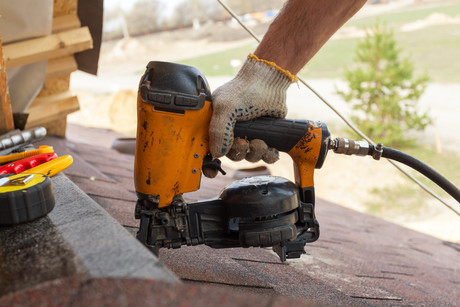Apprentice nail gun injury under investigation

Investigations are underway after a Queensland apprentice was injured by a nail that was fired by another worker’s nail gun. It was reported that the nail went through a piece of timber that the apprentice was holding and into his chest. He underwent minor surgery to remove a small piece of bone.
According to Workplace Health and Safety Queensland, most injuries from nail guns are caused by the user accidentally striking the gun’s muzzle into a part of the body while holding the tool’s trigger switch. However, there is also a risk of nails penetrating a person’s body as a result of:
- direct contact with the muzzle of a loaded gun
- deflection, when skewing off a hard surface
- firing through a soft material.
WHSQ has provided the following information to help prevent a similar incident from occurring:
Working from ladders or awkward positions can also expose workers to the projectile path of a nail gun. In such circumstances it is important that the correct type of nail gun is selected. A sequential fire nail gun allows for only a single fire from the trigger once the muzzle makes contact. These nail guns reduce the risk of accidental firing when handling the gun and when in restricted work areas.
Bump fire nail guns allow repetitive firing of nails while the trigger is engaged and every time the muzzle is bumped. While ideal for reducing the risk of musculoskeletal injury for jobs that involve high-volume production and repetitive tasks, bump fire nail guns must never be used:
- when the user is required to climb ladders or other elevated areas with a loaded gun
- in restricted and tight spaces where the gun’s muzzle could be bumped
- when other people could come within the nail gun’s firing path, or there is a foreseeable risk of being struck by a flying nail (e.g. by ricochet or deflection).
All workers who use any type of nail gun should be trained in how to use it safely. Training should cover:
- the safe operation of the nail gun
- PPE requirements
- any other specific directions as stated in the manufacturer’s manual.
Nail guns must also be maintained to ensure the firing mechanism is operating correctly. Any problems with the tools should be repaired by a competent person (i.e. an authorised agent) or be replaced.
For more information on the safe use of nail guns, download the WHSQ information PDF.
Do a young worker safety check-up this NSW Youth Week
With more than 15,000 of the state's 25-and-unders injured each year, SafeWork NSW is urging...
2025 Champions of Safety Awards nominations close 4 April
Nominations for the 2025 Champions of Safety Awards — an initiative by the Workplace Health...
Move to make SafeWork NSW "a regulator with teeth"
NSW has passed legislation to officially establish SafeWork NSW as a standalone regulator —...










